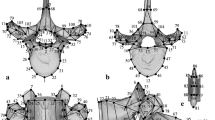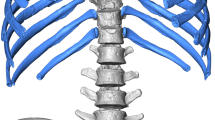Abstract
While a relatively broad thorax and strongly curved ribs are widely regarded as common features of living hominoids, few studies have quantitatively examined these traits by methods other than calculating the chest index. The present study aims to quantify variations in thoracic cage morphology for living anthropoids. The odd-numbered ribs (first to eleventh) were articulated with the corresponding vertebrae and the cranial and lateral views subsequently photographed. Rib profiles were digitized in both views and line-fitted by a Bézier curve to create a three-dimensional morphological data set. When thoracic cage width was scaled against body mass, Hylobates (and possibly Pongo) plotted above non-hominoid anthropoids at almost all rib levels, while Pan did not differ from non-hominoid anthropoids. The overall pattern of the normalized thoracic width differed between Hylobates and other hominoids. In Hylobates, an upward convex curve was seen between the first and seventh ribs while a more linear pattern was observed in Pan and Pongo. This result quantitatively confirmed that the barrel-shaped thoracic cage in Hylobates can be distinguished from the funnel-shaped form in other hominoids. Conversely, all hominoids shared two distinct features in the upper half-thorax: (1) a pronounced dorsal protrusion of the proximal part of the rib in accordance with ventral displacement of the thoracic spine and (2) a relatively medially projecting sternal end. Although these features are likely to provide some mechanical advantage in orthograde and/or suspensory positional behaviors, they were barely present in the suspensory Ateles.






Similar content being viewed by others
References
Andrews P, Groves CP (1976) Gibbons and brachiation. In: Rambaugh DM (ed) Gibbon and Siamang, vol 4: suspensory behavior, locomotion, and other behaviors of captive gibbons. S Karger, Basel, pp 167–218
Cartmill M, Milton K (1977) The lorisiform wrist joint and the evolution of “brachiating” adaptations in the Hominoidea. Am J Phys Anthropol 47:249–272
Chan LK (1997) Thoracic shape and shoulder biomechanics in primates. PhD thesis, Duke University, Durham
Chan LK (2007) Scapular position in primates. Folia Primatol 78:19–35
Erikson GE (1963) Brachiation in New World monkeys and in anthropoid apes. Symp Zool Soc Lond 10:135–164
Fleagle JG (1976) Locomotion and posture of the Malayan siamang and implications for hominoid evolution. Folia Primatol 26:245–269
Gebo DL (eds) (1993) Postcranial adaptation in nonhuman primates. Northern Illinois University Press, DeKalb
Gebo DL (1996) Climbing, brachiation, and terrestrial quadrupedalism: historical precursors of hominid bipedalism. Am J Phys Anthropol 101:55–92
Gehr P, Mwangi DK, Ammann A, Maloiy GMO, Taylor CR, Weibel ER (1981) Design of the mammalian respiratory system. V. Scaling morphometric pulmonary diffusing capacity to body mass: wild and domestic mammals. Respir Physiol 44:61–86
Harrison T (1986) A reassessment of the phylogenetic relationships of Oreopithecus bambolii Gervais. J Hum Evol 15:541–583
Harrison T (1991) The implications of Oreopithecus bambolii for the origins of bipedalism. In: Coppens Y, Senut B (eds) Origine(s) de la Bipédie chez les Hominidés. CNRS, Paris, pp 235–244
Hosaka M (1992) Modeling of curves and surfaces in CAD/CAM. Springer, Berlin
Huitema BE (1980) The analysis of covariance and alternatives. Wiley, New York
Hunt KD (1991a) Positional behavior in the Hominoidea. Int J Primatol 12:95–118
Hunt KD (1991b) Mechanical implications of chimpanzee positional behavior. Am J Phys Anthropol 86:521–536
Hurov JR (1987) Terrestrial locomotion and back anatomy in vervets (Cercopithecus aethiops) and patas monkeys (Erythrocebus patas). Am J Primatol 13:297–311
Jellema LM, Latimer B, Walker A (1993) The rib cage. In: Walker A, Leakey R (eds) The Nariokotome Homo erectus skeleton. Harvard University Press, Cambridge, pp 294–325
Jungers WL (1984) Scaling of the hominoid locomotor skeleton with special reference to lesser apes. In: Preuschoft H, Chivers DJ, Brockelman WY, Creel N (eds) The lesser apes: evolutionary and behavioural biology. Edinburgh University Press, Edinburgh, pp 146–169
Larson SG (1988) Subscapularis function in gibbons and chimpanzees: implications for interpretation of humeral head torsion in hominoids. Am J Phys Anthropol 76:449–462
Larson SG (1998) Parallel evolution in the hominoid trunk and forelimb. Evol Anthropol 6:87–99
MacLatchy L, Gebo D, Kityo R, Pilbeam D (2000) Postcranial functional morphology of Morotopithecus bishopi, with implications for the evolution of modern ape locomotion. J Hum Evol 39:159–183
Moyà-Solà S, Köhler M (1996) A Dryopithecus skeleton and the origins of great-ape locomotion. Nature 379:156–159
Moyà-Solà S, Köhler M, Alba DM, Casanovas-Vilar I, Galindo J (2004) Pierolapithecus catalaunicus, a new Middle Miocene great ape from Spain. Nature 306:1339–1344
Nakatsukasa M, Kunimatsu Y, Nakano Y, Ishida H (2007) Vertebral morphology of Nacholapithecus kerioi based on KNM-BG 35250. J Hum Evol 52:347–369
Ohman JC (1986) The first rib of hominoids. Am J Phys Anthropol 70:209–229
Payseur BA, Covert HH, Vinyard CJ, Dagosto M (1999) New body mass estimates for Omomys carteri, a Middle Eocene primate from North America. Am J Phys Anthropol 109:41–52
Pilbeam D, Rose MD, Barry JC, Shah SMI (1990) New Sivapithecus humeri from Pakistan and the relationship of Sivapithecus and Pongo. Nature 348:237–239
Preuschoft H, Schmidt M, Hayama S, Okada M (2003) The influence of three-dimensional movements of the forelimb on the shape of the thorax and its importance for erect body posture. Cour Forsch Inst Senck 243:9–24
Rose MD (1988) Another look at the anthropoid elbow. J Hum Evol 17:193–224
Rose MD (1989) New postcranial specimens of catarrhines from the Middle Miocene Chinji Formation, Pakistan: descriptions and a discussion of proximal humeral functional morphology in anthropoids. J Hum Evol 18:131–162
Ruff CB (2003) Long bone articular and diaphyseal structure in Old World monkeys and apes. II: estimation of body mass. Am J Phys Anthropol 120:16–37
Sarmiento EE (1995) Cautious climbing and folivory: a model of hominoid differentiation. Hum Evol 10:289–321
Sawyer GJ, Maley B (2005) Neanderthal reconstructed. Anat Rec Part B 283:23–31
Schmid P (1983) Eine Rekonstrucktion des Skelettes von A.L. 288–1 (Hadar) und deren Konsequenzen. Folia Primatol 40:283–306
Schmid P (1991) The trunk of the australopithecines. In: Coppens Y, Senut B (eds) Origine(s) de la Bipédie chez les Hominidés. CNRS, Paris, pp 225–234
Schultz AH (1930) The skeleton of the trunk and limbs of higher primates. Hum Biol 2:303–438
Schultz AH (1941) Growth and development of the orang-utan. Contrib Embryol 29:57–110
Schultz AH (1942) Growth and development of the proboscis monkey. Bull Mus Comp Zool 89:277–314
Schultz AH (1956) Postembryonic age changes. Primatologia 1:887–964
Schultz AH (1960) Einige Beobachtungen und Masse am Skelett von Oreopithecus im Vergleich mit anderen catarrhinen Primaten. Z Morphol Anthropol 50:136–149
Schultz AH (1961) Vertebral column and thorax. Primatologia 4:1–66
Shea BT (1981) Relative growth of the limbs and trunk in the African apes. Am J Phys Anthropol 56:179–201
Takahashi LK (1990) Morphological basis of arm-swinging: multivariate analyses of the forelimbs of Hylobates and Ateles. Folia Primatol 54:70–85
Voisin JL (2006) Clavicle, a neglected bone: morphology and relation to arm movements and shoulder architecture in primates. Anat Rec Part A 288:944–953
Ward CV (1993) Torso morphology and locomotion in Proconsul nyanzae. Am J Phys Anthropol 92:291–328
Acknowledgments
This work was supported by JSPS-HOPE, a Grant for the Biodiversity Research of the 21st Century COE (A14), a Grant-in-Aid for Scientific Research on Priority Areas “Emergence of Adaptive Motor Function through Interaction between Body, Brain and Environment” and by the Cooperation Research Program of the Primate Research Institute, Kyoto University. We are grateful to Dr. Kunimatsu Yutaka, Primate Research Institute, Kyoto University, Japan; Dr. Takano Tomo, Japan Monkey Centre; Dr. Richard Kraft, The Bavarian State Collection of Zoology, München, Germany; and Professor Dr. Christoph P.E. Zollikofer and Dr. Marcia S. Ponce de León, University of Zürich, Switzerland, for their courtesy in allowing access to specimens.
Author information
Authors and Affiliations
Corresponding author
Additional information
An erratum to this article can be found at http://dx.doi.org/10.1007/s10329-007-0074-x
About this article
Cite this article
Kagaya, M., Ogihara, N. & Nakatsukasa, M. Morphological study of the anthropoid thoracic cage: scaling of thoracic width and an analysis of rib curvature. Primates 49, 89–99 (2008). https://doi.org/10.1007/s10329-007-0064-z
Received:
Accepted:
Published:
Issue Date:
DOI: https://doi.org/10.1007/s10329-007-0064-z




